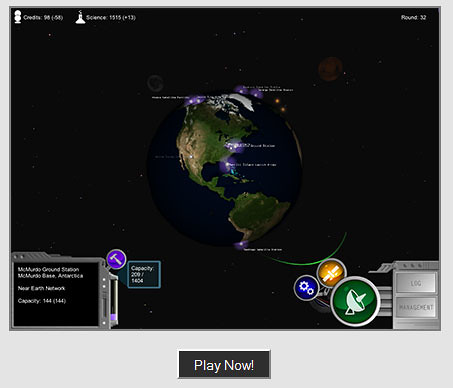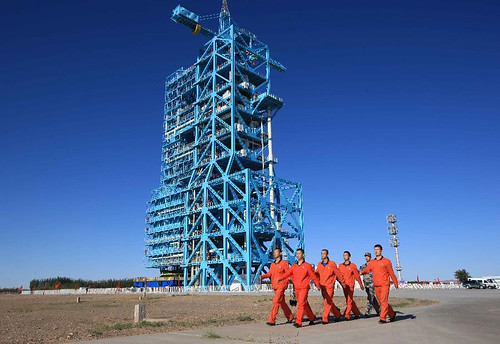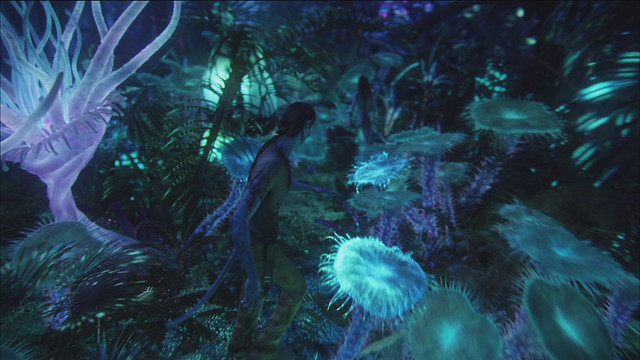Big Bang Monday: Mars Curiosity 360
Monday, August 20th, 2012
Mars Panorama – Curiosity rover: Martian solar day 2 in New Mexico
Very cool.
Hope more Mars images become available by our friends at Big Bang Prints soon.
Mars Panorama – Curiosity rover: Martian solar day 2 in New Mexico
Very cool.
Hope more Mars images become available by our friends at Big Bang Prints soon.
Lots of fakes out on YouTube. The above video is for real, hopefully, and deserves a look.
And you can always trust our friends at NASA. Take, for example, today’s APOD…

Perseid Meteors and the Milky Way
Image Credit & Copyright: Jens HackmannExplanation: Where will the next Perseid meteor appear? Sky enthusiasts who trekked outside for the Perseid meteor shower that peaked over the past few days typically had this question on their mind. Six meteors from this past weekend are visible in the above stacked image composite, including one bright fireball streaking along the band of the background Milky Way Galaxy. All Perseid meteors appear to come from the shower radiantin the constellation of Perseus. Early reports about this year’s Perseids indicate that as many as 100 meteors per hour were visible from some dark locations during the peak. The above digital mosaic was taken nearWeikersheim, Germany.
Growing Gallery: Perseid meteor shower image
Over 300 meteors captured in this one…
Thanks, NASA.
Missed the images from Mars over the last three years? Don’t worry, there’s a video.
If you’ve ever dreamed of visiting Mars, buckle up: The following video of NASA’s Mars Opportunity Rover crawling the surface of the red planet between September 2008 and August 2011 is about as close as you’re going to come at this point.
Opportunity’s panoramic still-image camera captured 309 photos as the rover crawled 13 miles to get from Martian Victoria to another, larger crater, the 14-mile-diameter Endeavor, where the rover is currently still located, busy inspecting Martian rocks. The still images were then stitched together to create the video slideshow. A soundtrack was also added by taking data from Opportunity’s accelerometers and speeding it up by 1,000 times to achieve an audible frequency.
If you’ve ever seen the movie Dune (1984), you’ll recall the dramatic worm sightings when you see the Mars terrain…

Now that World Space Week is over, its time to play games.
NASA just released NetworKing, a game based on how the Space Communication and Navigation (SCaN) network works:
Developed by the Information Technology Office at NASA’s Ames Research Center at Moffett Field, Calif., NetworKing gives players an insider’s perspective into how astronauts, mission controllers and scientists communicate during space missions.
“For any young person who ever dreamed of one day contributing to space missions, NetworKing lets players develop a kingdom of multiple space communication networks working together to support space missions,” said Barbara Adde, policy and strategic communications director for SCaN at NASA Headquarters in Washington.
To successfully construct fast and efficient communication networks, players must first establish command stations around the world and accept clients conducting space missions, such as satellites and space telescopes. Resources are earned throughout the game as players continue to acquire more clients. Players can strategically use accumulated resources to enhance and increase their networks’ capabilities.
Players with the most integrated communications networks will have the ability to acquire more complex clients, such as the International Space Station, Hubble Space Telescope and the Kepler mission.
“As a simple and fun introduction to the complex world of space communications, NetworKing gives players the opportunity to enjoy a challenging game while absorbing the basic concepts of space communication,” said Daniel Laughlin, games researcher at NASA’s Goddard Space Flight Center in Greenbelt, Md. “It’s an engaging way to increase interest in science, technology, engineering and mathematics areas of study and open minds to potential careers in those fields.”
Awesome game.

动画演示“天宫一号”发射全过程
China’s Tiangong-1 is set to launch into low-earth orbit today, with the hopes of some day building a space station to rival the ISS.
Do they have a plan to dominate space? Not really. Dr. Morris Jones of Australia explains all in Space Daily…
This module is a small space laboratory with a single docking port. It is not the first module of a large Chinese space station, as some media reports are saying.
Tiangong 1 will test some of the technologies that will be used to build a large Chinese space station in the future, but it is not even a prototype of the modules that will be used to build the station.
Tiangong 1 will be used as a rendezvous and docking target for the unmanned Shenzhou 8 spacecraft, which will launch before the end of this year. China has never docked two spacecraft before. Shenzhou 8 will stay docked with Tiangong 1 for about three weeks, and will then send its descent module to a soft landing back on Earth.
If all has gone well with this flight, we can expect Shenzhou 9 to fly to Tiangong 1 in 2012, this time with astronauts aboard. They will live aboard the laboratory and their docked Shenzhou spacecraft for a short mission, then come home. Later in 2012, the Shenzhou 10 mission will also fly to Tiangong 1, delivering its second (and probably final) crew.
At this stage, we don’t know how many astronauts will be aboard Shenzhou 9 or 10. A maximum of three crewmembers can fly aboard one of these spacecraft. It’s possible that there will be two or three astronauts on these expeditions. At least one of the missions is expected to carry China’s first female astronaut.
Tiangong 1 is a vital step in China’s quest to develop a space station, but it must be seen as an intermediate program. Two more Tiangong laboratories are expected to be launched by China in the years ahead, gradually testing more technology for the space station.
Tiangong 3 is expected to have more than one docking port, and will possibly see another regular Tiangong module docked with it before a crew is launched there.
When China’s space station is finally assembled in orbit around 2020, the Tiangong spacecraft will see a new lease of life. It will be refitted to serve as a cargo carrier, delivering food and other supplies to the astronauts aboard the space station.
Yes, it’s a wonderful program, and we’ve been waiting a long time to see Tiangong fly. But please don’t confuse it with the next step in China’s space program. When the final space station is built, it will eclipse the modestly sized Tiangong laboratory in terms of size, performance and achievements.
Good luck!
STS-135 launch video — the last one.

One of many interesting, fantastic details of the film “Avatar” was the bioluminescent plants — and the inter-networked biosystems on Pandora.
Why am I thinking about this? NASA just released details of maps illustrating land plant fluorescence, based on the work of several scientists who published “First observations of global and seasonal terrestrial chlorophyll fluorescence from space.” The abstract:
Remote sensing of terrestrial vegetation fluorescence from space is of interest because it can potentially provide global coverage of the functional status of vegetation. For example, fluorescence observations may provide a means to detect vegetation stress before chlorophyll reductions take place. Although there have been many measurements of fluorescence from ground- and airborne-based instruments, there has been scant information available from satellites. In this work, we use high-spectral resolution data from the Thermal And Near-infrared Sensor for carbon Observation – Fourier Transform Spectrometer (TANSO-FTS) on the Japanese Greenhouse gases Observing SATellite (GOSAT) that is in a sun-synchronous orbit with an equator crossing time near 13:00 LT. We use filling-in of the potassium (K) I solar Fraunhofer line near 770 nm to derive chlorophyll fluorescence and related parameters such as the fluorescence yield at that wavelength. We map these parameters globally for two months (July and December 2009) and show a full seasonal cycle for several different locations, including two in the Amazonia region. We also compare the derived fluorescence information with that provided by the MODIS Enhanced Vegetation Index (EVI). These comparisons show that for several areas these two indices exhibit different seasonality and/or relative intensity variations, and that changes in fluorescence frequently lead those seen in the EVI for those regions. The derived fluorescence therefore provides information that is related to, but independent of the reflectance.

Real science is never too far from science fiction, is it?
That reminds me: I should water the garden.

There’s got to be a good story behind this one. Some looney wanted to sell moon rocks. Yeah, she’s from California…
A woman who tried to sell what she said was a rare piece of moon rock for $1.7 million was detained when her would-be buyer turned out to be an undercover NASA agent, officials said Friday.
The gray rocks, which are considered national treasures and are illegal to sell, were given to each U.S. state and 136 countries by then-President Richard Nixon after U.S. moon missions and can sell for millions of dollars on the black market.
NASA investigators and Riverside County sheriff’s deputies detained the woman after she met Thursday with an undercover NASA investigator at a restaurant in Lake Elsinore, about 70 miles southeast of Los Angeles, the sheriff’s office said. The investigation was conducted over several months.
Authorities swooped after the two agreed on a price and the woman, whose name has not been released, pulled out the rock.NASA planned to conduct tests to determine whether the rock came from the moon as the woman claimed.
“We don’t know if it’s lunar material,” said Gail Robinson, deputy inspector general at the space agency.
Joseph Gutheinz, a University of Phoenix instructor and former NASA investigator who has spent years tracking down missing moon rocks, said a lunar curator at a special lab at Johnson Space Center would carry out the testing. Among the substances the rock could contain is armalcolite, a mineral first discovered on the moon and named for Neil Armstrong, Buzz Aldrin and Michael Collins, who was on the Apollo 11 lunar mission crew.
The woman has not been arrested or charged. It was unknown how she obtained the rock or came to the attention of NASA.
Gutheinz said the woman could face theft charges if the rock is genuine, or fraud charges if it is not.
What would you do with a moon rock if you had one? “That’s my moon rock.”
“You’re a looney!”
 In addition to Cornell’s cracker-sized satellite, another part of STS-134‘s payload is WISPERS or Canary — a plasma spectrometer designed and built by the Applied Physics Lab at Johns Hopkins University in Laurel, Maryland.
In addition to Cornell’s cracker-sized satellite, another part of STS-134‘s payload is WISPERS or Canary — a plasma spectrometer designed and built by the Applied Physics Lab at Johns Hopkins University in Laurel, Maryland.
Canary, a plasma spectrometer, will investigate the interaction of approaching spacecraft with the background plasma environment around the ISS and disturbances in the ionosphere caused by space vehicles. The device will also provide a better understanding of the origin and impact of plasma irregularities in the Earth’s ionosphere, and demonstrate low-cost techniques for monitoring those conditions. Canary is the second Wafer Integrated Plasma Spectrometers (WISPERS) device created by APL; engineers used innovative MicroElectroMechanical (MEMS) technology when designing WISPERS to reduce size and energy consumption while increasing sensitivity. The first WISPERS device was launched last year aboard FalconSat-5. “Canary and WISPERS will provide on-orbit data for understanding how spacecraft operations affect the natural environment,” says Robert Osiander, principal investigator for WISPERS at APL.
Canary gathers particles of plasma (an electrically-charged gas) through a hole smaller than the diameter of a human hair; the particles are then sorted according to energy and type by a titanium electrostatic analyzer less than a tenth of an inch thick. By measuring the type and energy levels of plasma around it, Canary can provide warnings of potentially hazardous operating conditions.“Canary will add an important new tool to those we use to understand the near-Earth space environment,” says Larry Paxton, a space scientist at APL and member of the Canary team. “Canary will also demonstrate a new, cost-effective approach to supporting our nation’s operations in space.”
Canary was built by APL in coordination with the Space Physics and Atmospheric Research Center (SPARC) at the U.S. Air Force Academy, and was funded in part by the Naval Research Laboratory‘s Operationally Responsive Space (ORS) program. Canary is part of the STP-H3 payload, which is integrated and flown under the direction of the Department of Defense’s Space Test Program. Canary is scheduled to be installed on the ISS on flight day 3.
